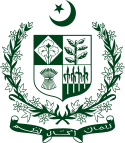
Back পাকিস্তানের সাধারণ নির্বাচন, ২০১৩ Bengali/Bangla Parlamentswahlen in Pakistan 2013 German Πακιστανικές βουλευτικές εκλογές (2013) Greek Élections législatives pakistanaises de 2013 French Pemilihan umum Pakistan 2013 ID Elezioni parlamentari in Pakistan del 2013 Italian Pilihan raya umum Pakistan 2013 Malay پاکستان دے عام انتخابات، 2013ء PNB Парламентские выборы в Пакистане (2013) Russian پاکستان کے عام انتخابات، 2013ء Urdu
| |||||||||||||||||||||||||||||||||||||
All 342 seats in the National Assembly 172 seats needed for a majority | |||||||||||||||||||||||||||||||||||||
|---|---|---|---|---|---|---|---|---|---|---|---|---|---|---|---|---|---|---|---|---|---|---|---|---|---|---|---|---|---|---|---|---|---|---|---|---|---|
| Turnout | 55.02%[1]( | ||||||||||||||||||||||||||||||||||||
| |||||||||||||||||||||||||||||||||||||
 Results by constituency | |||||||||||||||||||||||||||||||||||||
| |||||||||||||||||||||||||||||||||||||
 |
|---|
|
|

General elections were held in Pakistan on Saturday 11 May 2013 to elect the members of the 14th National Assembly and the four Provincial Assemblies. The three major parties were the Pakistan Muslim League (N) (PML-N) led by Nawaz Sharif, the Pakistan People's Party (PPP) led by President Asif Ali Zardari and the Pakistan Tehreek-e-Insaf (PTI) led by Imran Khan. Prior to the elections, the ruling PPP formed an alliance with the Pakistan Muslim League (Q) and Awami National Party, while the main opposition party, the PML-N allied with the Pakistan Muslim League (F) and Baloch parties. The PTI led by cricketer-turned-politician Imran Khan, also emerged as a key-player.
The result was a hung parliament,[3] with the PML-N receiving the most votes and winning the most seats, but falling six seats short of a majority.[4] However, following the elections, 19 independent MPs joined the PML-N, allowing it to form a government alone with Nawaz Sharif as new Prime Minister.[5]
In the provincial elections, the PPP was able to defend its majority in Sindh. The PTI won the most seats in Khyber Pakhtunkhwa, the first time it had gained control of a province. The PML-N emerged as the largest party in Punjab and Balochistan.[6][7][8][9]
The elections were the first civilian transfer of power following the successful completion of a five-year term by a democratically elected government.[10]
- ^ "Pakistan elections 2013 total voter turnout: 55%". The Express Tribune. 21 May 2013.
- ^ a b National Assembly database. "Swing and Party statistics". National Assembly database. Retrieved 2 May 2014.
- ^ "Sharif seeks Pakistan majority – ITV News". Itv.com. 11 May 2013. Retrieved 22 July 2013.
- ^ PTI (16 May 2013). "Nawaz Sharif's PML-N gets 124 seats in Pakistan National Assembly". India Times. Retrieved 22 July 2013.
- ^ "Nawaz Sharif's PML-N emerges as single largest party in Pak polls". Zeenews.india.com. 14 May 2013. Retrieved 22 July 2013.
- ^ "Elections: PTI to work out seat adjustment with JI". The Express Tribune. 24 March 2013. Retrieved 18 April 2013.
- ^ "PML-N cobbles electoral alliance with PML-F, NPP". The News. 27 February 2013. Archived from the original on 22 March 2013. Retrieved 23 March 2013.
- ^ Ali, Manzoor (18 March 2013). "Consensus: JI, PTI agree on electoral alliance". The Express Tribune. Retrieved 23 March 2013.
- ^ "PML-N sets condition for 'alliance' that PTI rules out". Dawn. 23 July 2012. Retrieved 23 March 2013.
- ^ "Historic election marks transition in Pakistan". Pri.Org. 14 May 2013. Archived from the original on 16 June 2013. Retrieved 22 July 2013.
© MMXXIII Rich X Search. We shall prevail. All rights reserved. Rich X Search




